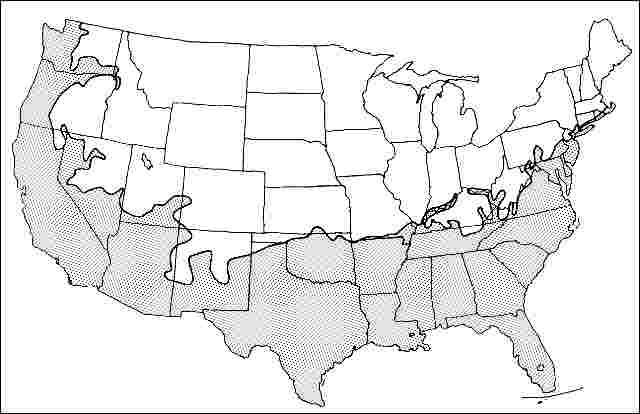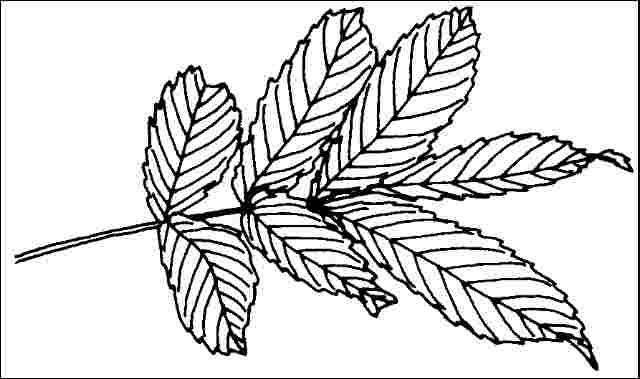Introduction
Chinese Wingnut is a 40 to 70-foot-tall, deciduous tree with large, substantial branches which spread as wide as the tree is tall. The 6 to 12-inch-long leaves are composed of many, finely-toothed, oval leaflets, and do not display any appreciable fall color. Of particular interest are the 6 to 12-inch-long seed clusters, green strings of winged seeds suspended below the branches which turn brown and fall in autumn. The tree grows at a phenomenal rate. A six-year-old tree in Raliegh was about 25 feet tall and wide with a 14-inch trunk diameter. The trunk can reportedly grow to at least eight feet in diameter.

Credit: Ed Gilman
General Information
Scientific name: Pterocarya stenoptera
Pronunciation: teer-oh-KAIR-ee-uh sten-OP-ter-uh
Common name(s): Chinese Wingnut
Family: Juglandaceae
USDA hardiness zones: 6B through 11 (Fig. 2)
Origin: not native to North America
Invasive potential: invasive non-native
Uses: street without sidewalk; shade
Availability: not native to North America

Description
Height: 40 to 70 feet
Spread: 40 to 60 feet
Crown uniformity: irregular
Crown shape: vase, round
Crown density: open
Growth rate: fast
Texture: coarse
Foliage
Leaf arrangement: alternate (Fig. 3)
Leaf type: odd-pinnately compound
Leaf margin: serrate
Leaf shape: oblong, elliptic (oval)
Leaf venation: pinnate
Leaf type and persistence: deciduous
Leaf blade length: 2 to 4 inches, 4 to 8 inches
Leaf color: green
Fall color: no color change
Fall characteristic: not showy

Flower
Flower color: green
Flower characteristics: not showy
Fruit
Fruit shape: elongated
Fruit length: .5 to 1 inch
Fruit covering: dry or hard
Fruit color: brown, green
Fruit characteristics: does not attract wildlife; showy; fruit/leaves a litter problem
Trunk and Branches
Trunk/bark/branches: branches don't droop; not showy; typically one trunk; thorns
Pruning requirement: needed for strong structure
Breakage: resistant
Current year twig color: brown
Current year twig thickness: thick
Wood specific gravity: unknown
Culture
Light requirement: full sun
Soil tolerances: clay; sand; loam; acidic; well-drained
Drought tolerance: high
Aerosol salt tolerance: unknown
Other
Roots: can form large surface roots
Winter interest: no
Outstanding tree: no
Ozone sensitivity: unknown
Verticillium wilt susceptibility: unknown
Pest resistance: free of serious pests and diseases
Use and Management
Chinese Wingnut may perform well as a street or shade tree but the aggressive roots may make it unsuitable for use in a lawn or garden. It should be considered for broader use as an urban tree but it is largely untested, so use it with caution. Locate it well away from (10 feet or more) a sidewalk or driveway so the large-diameter surface roots will not lift the concrete or asphalt.
Prune early in the life of the tree to form a good, strong structure by spacing major limbs several feet apart along a central trunk. Do not allow these limbs to grow more than about two-thirds the diameter of the trunk to encourage formation of a strong branch collar.
Chinese Wingnut grows quickly in full sun and moist soil, and is ideally located beside a stream or pond. The trees are tolerant of clay, wind, drought, and compacted soil once the trees have become well established. Any necessary pruning should be done in the summer to prevent the bleeding which occurs in spring or winter.
Propagation is by seed or cuttings.
Pests and Diseases
No pests or diseases are of major concern are known at this time.